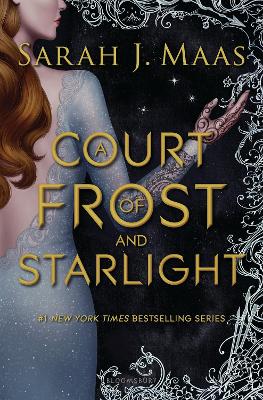Reviewed by Kate (Blogging with Dragons) on
With my perspective, I really liked the book’s focus on the characters and on their healing from the war, as well as the shifting point-of-view between the characters. It was great to get inside Rhysand, Cassian, and Mor’s heads. I felt even closer and more connected to the characters. As always, I also loved the close relationship of the gang—Cassian, Azriel, Mor, Rhysand, Feyre, and Amren, and of course, the banter between Feyre and Rhysand. As always, I was very interested in Lucien, Elain, and Azriel’s interactions, but there was just enough of it to tantalize. But as I was hungry for anything with these characters, I gobbled up the tease happily.
Though this book was not packed with romantic developments in many of my favorite ships, I was pleased with the further development between the Archeron sisters. In many fairy tale books, the sisters are perfect and best friends or the heroine is tormented by her evil sisters. Though the series may have started with Feyre being treated awfully by her sisters Elain and Nesta, it evolved into a complicated relationship that was filled with love, loyalty, resentment, and so many other emotions. I really enjoyed that Maas took the two sisters that I hated and twisted their existences upside down and tied them further to that of Feyre’s, Rhysand’s, and the rest of the gang’s fates.
I especially found it remarkable how lifelike it was for Nesta to not want to turn up to the Winter Solstice holiday, extort money in order to do so, and then ruin the rest of the evening for everyone else. To me, this was the exemplary kind of character development that makes the series shine, and is not often found in a young adult fantasy novella, of all things. As always, Maas excelled at breathing life into her characters and putting real people in fantastical worlds.
In this particular world, at the Night Court in Velaris, the gang were all preparing for the Winter Solstice, and coincidentally Feyre’s birthday. I enjoyed all their gift-buying preparations, but found it a little hard to believe that Feyre and Rhysand did not know what to buy each other. They have always been so obsessed with each other that their dilemma just did not quite seem believable to me. Though I loved Rhys’s gift of the sketchbooks and artist tools, I wished that he had bought Feyre the artist studio instead of the random house for to design. For goodness sake’s, he even stumbled across her painting in the abandoned studio—after she hadn’t picked up brushes in months—and then did not buy the studio, where she could finally manage to paint, for her. The gift of the house felt pretty inattentive for thoughtful Rhysand and like just another way for the author to state how rich, young, attractive, and powerful they all were, which honestly got a little old.
Despite these constant references, I relished the foreshadowing that was laced throughout the book, especially Rhys’s visit with a rapidly deteriorating Tamlin, and Mor’s sighting of something dark and dangerous in the woods. But most of all, I was totally floored by the excerpt at the end and what appeared to be Nesta’s training with Cassian and the Illyrian troops. Like most readers, I was somewhat disappointed with how Nesta was choosing to cope with the results of the last book—drinking, sleeping around, and cutting Cassian out of her life. But honestly, I wouldn’t change a thing because not only was Nesta interesting and firey as usual, but also appeared that all of this strife was leading to her enlisting—okay being forced into their ranks by Feyre and the gang as a type of intervention for her increasingly destructive behavior—into the Illyrian warriors with Cassian. I know that Nesta is going to be a complete and total badass and I honestly cannot wait to read it!
For those who love the characters, the Night Court in Velaris, and the world, you will certainly enjoy this book. As I am one of these readers, I welcomed the return to the series I loved. But if you are tight on money or do not enjoy books that are not filled with action and deep plots, and instead focus on character development, pass on it. There’s nothing in this book that won’t be referenced in the next.
Book Review Policy
Connect with Me:
Reading updates
- Started reading
- 30 May, 2018: Finished reading
- 30 May, 2018: Reviewed
